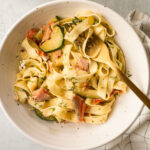Salmon Pasta Without Cream
Salmon pasta without cream, featuring dill, Parmesan, lemon zest, and a little yoghurt to make it moist and juicy. Ready in 20 minutes!
Servings: 2
Calories: 696kcal
Ingredients
- 6 tbsp yoghurt (Note 1)
- 15 g dill finely chopped (Note 2)
- 10 g Parmesan finely grated (Note 3)
- ½ lemon (zest only)
- ¼ tsp black pepper
- salt (optional, to taste)
- 200g long pasta (tagliatelle, spaghetti or linguine) (Note 4)
- 1 tbsp neutral oil
- 2 salmon fillets (around 120g or 4oz each) (Note 5)
- 30 g butter
- 1 medium zucchini/courgette halved vertically and sliced into semicircles (Note 6)
- 2 cloves garlic minced/crushed
- 60 ml white wine or chicken stock (Note 7)
- 1-2 tbsp reserved pasta water
Instructions
- Combine the yoghurt, dill, Parmesan, lemon zest, black pepper and salt in a bowl and set aside.
- Cook the pasta in a large pan of generously salted boiling water.
- Pat the salmon fillets dry with kitchen paper and sprinkle lightly with salt.
- Place a frying pan on a medium heat and add oil. When the oil is hot fry the salmon fillets for 2-3 minutes on each side until they are cooked through and set aside.
- Add the butter to the pan and fry the zucchini/courgette until it starts to brown.
- Then add the garlic and cook for a minute or two until fragrant.
- Pour on the wine and simmer until reduced by half. Then reduce the heat of the pan to low to prevent all the wine from evaporating while the pasta cooks.
- When the pasta is done, reserve some pasta water in a small jug or cup. before draining.
- Place the pasta into the pan with the wine and garlic. Add the yoghurt and dill mixture, 1-2 tablespoons of pasta water and gently toss together, adding more pasta water if needed.
- Remove the skin from the cooked salmon, roughly chop, and gently combine with the pasta.
- Serve immediately.
Notes
- Plain or Greek yoghurt: Makes the pasta moist and juicy. You can use full-fat, low fat or dairy-free.
- Salmon: You can use either wild-caught or farmed salmon, but please steer clear of smoked salmon fillets. Fresh trout fillets are a cheaper alternative that will also work well with the other elements in the dish.
- Fresh dill: Fresh parsley or chives would also work, although the recipe has not been tested with these. I strongly recommend using fresh herbs instead of dry ones.
- Parmesan: Can be swapped for nutritional yeast for a dairy-free alternative.
- Pasta: This comes down to personal preference. I like to use long pasta varieties like tagliatelle, linguine or spaghetti, but feel free to use another type if you prefer.
- White wine: Adds depth and complexity. Choose one that's dry, crisp, and has a good level of acidity like Sauvignon Blanc, Pinot Grigio or Chardonnay. Avoid sweet wines that will make the flavours in the dish unbalanced. Use chicken or veg stock for an alcohol-free option.
- Zucchini /courgette: Substitute with other green veggies like spinach or asparagus.
Nutrition
Serving: 1serving | Calories: 696kcal | Carbohydrates: 77g | Protein: 51g | Fat: 17g | Saturated Fat: 4g | Polyunsaturated Fat: 6g | Monounsaturated Fat: 5g | Trans Fat: 0.1g | Cholesterol: 181mg | Sodium: 190mg | Potassium: 1432mg | Fiber: 5g | Sugar: 5g | Vitamin A: 946IU | Vitamin C: 27mg | Calcium: 157mg | Iron: 4mg
